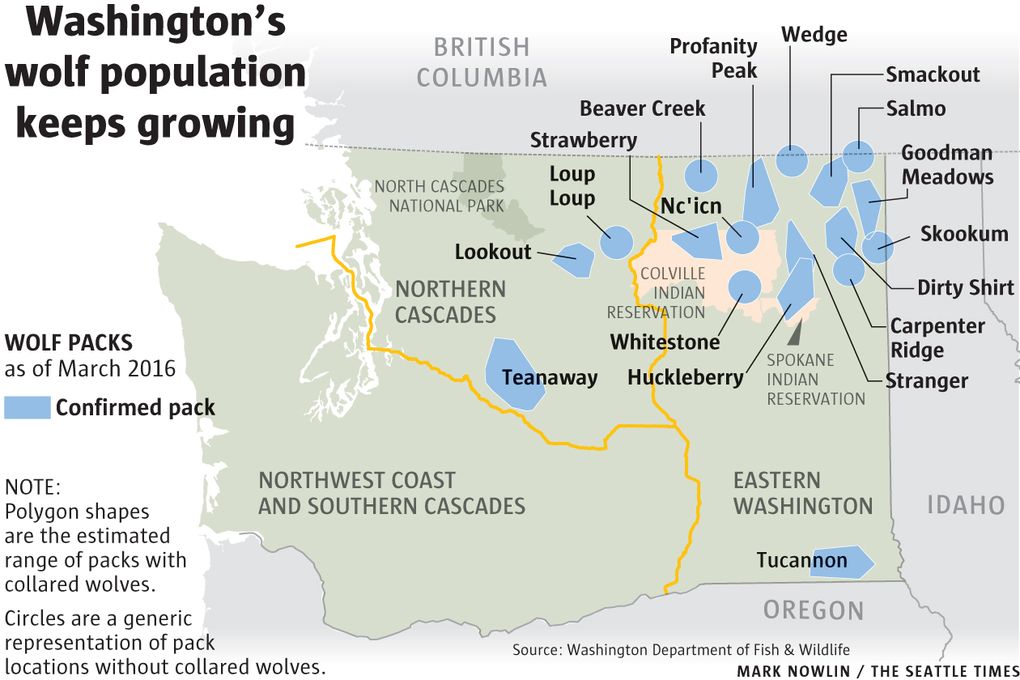
Washington wolf populations have grown 36 percent per year on average since 2008, the newest state survey shows.
The state’s most recent population survey, completed this month, shows at least four new packs in the state: the Beaver Creek, Loup Loup, Skookum and Stranger packs in Ferry, Okanogan, Pend Oreille and Stevens counties, respectively.
By the end of 2015, the state was home to at least 90 wolves, in 18 packs and eight breeding pairs, according to the Washington Department of Fish and Wildlife survey released Monday.
The number of wolves grew by 32 percent last year, despite the deaths of seven wolves from various human causes, including legal hunting on the Spokane Indian Reservation, where the tribe authorizes the hunting of up to six wolves per year by its members. Three wolves in all were killed by tribal hunters last year.
The four other deaths included one wolf hit by a car that had been recovering from gunshot wounds to the leg; and a wolf shot by a Columbia County property owner from his porch because he was concerned for his dogs and family. That wolf had been collared in Oregon and was found to be undernourished and suffering from infected birdshot wounds to the head. A third wolf died during an attempt to capture it.
The fourth wolf’s cause of death is unknown.
Despite the deaths, since 2008, when the department documented just one pack and five wolves in Washington, the population has increased by an average 36 percent per year.
However, two other packs disappeared from the state last year: the Wenatchee pack, which could not be located; and the Diamond Pack, which moved to Idaho and is no longer counted in Washington totals.
Even though the number of wolves is growing in the state, there were fewer conflicts with livestock in 2015 than in the previous year. The department counted seven cattle and one guard dog injured by wolves from four packs in 2015.
Preventive measures, including a program that provides horseback riders to create an increased human presence in grazing areas, seem to be helping. Others include using shepherds and guard dogs with sheep, to keeping watch over lambing and calving pens. Human presence with livestock animals makes the difference.
“It’s encouraging to see continuation toward our objective of increasing populations along with reductions in wolf-livestock conflict,” said Donny Martorello, carnivore specialist with the department.
He noted that last year the department stepped up its efforts with livestock producers to provide radio-collar data to help range riders run interference between cattle and wolves; train range riders to recognize wolf activity; and urge producers to keep ahead of problems by not allowing animal carcasses to remain on rangelands, possibly attracting wolves.
Gray wolves were all but eliminated throughout the Western states in the last century by shooting, trapping and poisoning. Today, wolves are protected under Washington law throughout the state, and under the federal Endangered Species Act west of Highway 97.
“It’s definitely good news that the population is going up,” said Amaroq Weiss, West Coast wolf organizer for the Center for Biological Diversity. “But the fact is this much of an increase shows the population is still in early stages of recovery. It’s thumbs up, but we obviously still need protection.”
Survey results are approximate because the wolves are hard to track. The state did the research for this survey using planes, remote cameras, following wolf tracks and signals from 22 radio-collared wolves from 13 packs. A total of 12 more wolves were fitted with radio collars during the year.
A pack is defined as two or more wolves traveling together in winter. A successful breeding pair is an adult male and female with at least two pups that survive to the end of the calendar year.
***
Information on wolves in Washington
Source: Washington Department of Fish and Wildlife
source


No comments:
Post a Comment